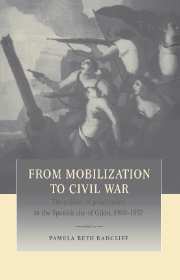Book contents
- Frontmatter
- Contents
- List of maps
- List of tables
- Acknowledgments
- Glossary of terms and abbreviations
- Introduction
- 1 A turning point: the city in 1900
- PART I Patterns of life in working-class Gijón
- PART II Institutional forces of opposition: republicans and anarchosyndicalists
- PART III Defining an oppositional culture: the struggle over the public sphere
- PART IV The urban battlefield: conflict and collective action, 1901–1936
- 9 Conflict and collective action, 1901–1930
- 10 Conflict and collective action during the Republic, 1931–1936
- Conclusion
- Appendix 1 Wage and price movement
- Appendix 2 Occupations by status category
- Appendix 3 Supplementary tables
- Select bibliography
- Index
10 - Conflict and collective action during the Republic, 1931–1936
Published online by Cambridge University Press: 31 October 2009
- Frontmatter
- Contents
- List of maps
- List of tables
- Acknowledgments
- Glossary of terms and abbreviations
- Introduction
- 1 A turning point: the city in 1900
- PART I Patterns of life in working-class Gijón
- PART II Institutional forces of opposition: republicans and anarchosyndicalists
- PART III Defining an oppositional culture: the struggle over the public sphere
- PART IV The urban battlefield: conflict and collective action, 1901–1936
- 9 Conflict and collective action, 1901–1930
- 10 Conflict and collective action during the Republic, 1931–1936
- Conclusion
- Appendix 1 Wage and price movement
- Appendix 2 Occupations by status category
- Appendix 3 Supplementary tables
- Select bibliography
- Index
Summary
On December 15, 1930, the city of Gijón erupted in the first major conflagration since the 1923 coup. The spark was provided by the execution on December 14th of Captains Galán and García Hernández, who had led an unsuccessful republican uprising in the town of Jaca. Ironically, the defeat at Jaca helped revitalize the antimonarchical forces, which swept into power several months later. Thus, in Gijón, the massive protest against the executions confirmed the widespread lack of confidence in the struggling monarchy and the popular demand for political change. Republican candidates rode the tide of this popular mandate in a broad coalition that won an overwhelming victory in the April 1931 elections. In the optimism of the moment, it seemed as if “smoke-darkened” Gijón had finally seized the reigns of power and taken over both the city and the country from the economic and social elites.
What soon became apparent, however, was that the inauguration of the Republic marked a new phase in, rather than the end of, the ongoing battle for control of the city. When the republican government failed to demonstrate its clear loyalty to “smoke-darkened” Gijón, the republicans lost what was left of their ambiguous leadership of the popular community. Set adrift from the moderating republican influence, the remaining oppositional forces pursued their unmediated war against the elite forces of the city, which also refused to trust the government with their interests. With the Republic caught helplessly in the middle, the polarization of left and right, popular and elite, continued unabated, directly contested in the streets and in the workplaces as it had been for several decades, and culminating in armed confrontation in October 1934 and July …
- Type
- Chapter
- Information
- From Mobilization to Civil WarThe Politics of Polarization in the Spanish City of Gijón, 1900–1937, pp. 280 - 304Publisher: Cambridge University PressPrint publication year: 1997



